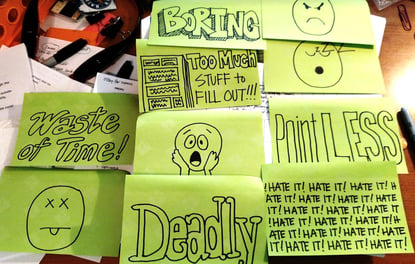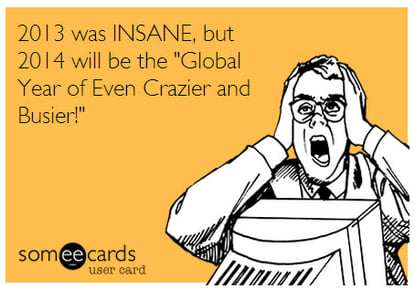What better place for adults to meet than LEGOLAND Discovery Center?
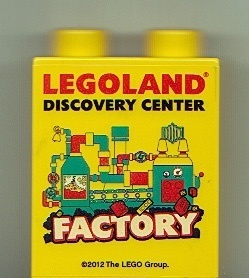 On Saturday morning, I met there with Chris Reaburn and his son Clarkson. Traveling through Kansas City for just one day, I suggested meeting at LEGOLAND Discovery Center so we could talk while Clarkson played.
On Saturday morning, I met there with Chris Reaburn and his son Clarkson. Traveling through Kansas City for just one day, I suggested meeting at LEGOLAND Discovery Center so we could talk while Clarkson played.
Why this suggestion?
Because adults unaccompanied by kids (i.e., me) aren’t admitted to LEGOLAND other than one night a month. As a result, I haven’t been able to go there since its opening.
The idea was a great one, in theory, but too late to buy tickets online, we found ourselves in a 3-line deep queue of people during (according to the LEGOLAND website) a high demand period. Arriving 15 minutes after opening didn’t help; I learned (secondhand) from someone in line the wait from where I was would be at least 60 minutes. And that would be just to get to the door to go inside and buy tickets.
I’m NOT good at waiting in lines, so I let Chris know if Clarkson wasn’t up for the wait we could leave without ME throwing a fit about not seeing LEGOLAND.
Clarkson was a great sport, however, during our hour wait outside. He amused himself with LEGO bricks from several bowls placed throughout the line. Clarkson and Chris also navigated several trips across lines of waiting families to get child-sized water cups from a centrally located water stand.
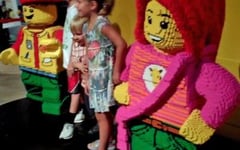 After making it inside to buy tickets, we faced another wait for elevators to the main floor. This extended pause involved a photo (bomb) opportunity for kids with life-sized LEGO characters. The elevator ride’s conclusion put us in the LEGO Factory - learning about how LEGOs are made, seeing the LEGO master builder workshop, and finding out how much we weigh in LEGO bricks (let’s just say more than 30,000).
After making it inside to buy tickets, we faced another wait for elevators to the main floor. This extended pause involved a photo (bomb) opportunity for kids with life-sized LEGO characters. The elevator ride’s conclusion put us in the LEGO Factory - learning about how LEGOs are made, seeing the LEGO master builder workshop, and finding out how much we weigh in LEGO bricks (let’s just say more than 30,000).
After the LEGO Factory, we were in yet another line for a Kingdom Quest ride. At Clarkson’s request (or maybe it was a Chris decision), we skipped the ride to finally enter the main LEGOLAND Discovery Center attraction.
Managing Customer Expectations – 5 Lessons for Brands that Make Customers Wait
Before getting a chance to skip Kingdom Quest, Chris and I both commented how the LEGOLAND Discovery Center didn’t manage customer expectations even remotely as well as Disney does at its attractions. It was then we realized LEGOLAND HAD started managing time expectations once we got to the elevator room. That was way too late though – starting more than hour after we arrived on property. Admittedly, there were very few tantrums in line from kids. Yet LEGOLAND is missing opportunities to shape customer expectations and extend its brand experience more positively for one-third of our three hour visit.
If you’ve ever been to a Disney park, it is clear Disney is a master of managing time expectations to make time pass more quickly than you’d expect. From our weekend experience, LEGOLAND could learn a lot from Disney and other brands that manage time well. So not from a management science perspective (which frankly was NOT one of my favorite MBA classes), but from the experience of standing in too many lines in my life, here are five ideas LEGOLAND (or any other brand that queues up customers for a prolonged wait) should consider:
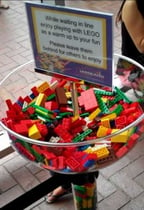 1. Start managing the brand experience as soon as you can / as soon as you need to start
1. Start managing the brand experience as soon as you can / as soon as you need to start
As soon as customers start thinking they’re on your brand’s “property,” begin managing time expectations. LEGOLAND did this to some extent with online tickets promising shorter waits and the onsite LEGO brick bowls and water stand. But since the most readily available parking is across the street in a multi-level shopping center parking lot, it would be great to see more directional signage right away to identify the fastest route to LEGOLAND from the garage.
Tip: Start managing time expectations as close as you can to your brand’s Zero Moment of Truth.
2. Get people “inside” right away and create experiential variety
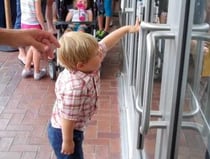 It was overcast and cooler given Kansas City’s summer, so our hour-long outdoor wait could have been much more brutal. In any event, the LEGOLAND Discovery Center is failing to bring people “inside” a more structured brand experience as soon as possible. This could happen by extending the waiting area’s physical environment (necessitating re-design / construction) or by creating more experiences and visual variety in line. LEGOLAND had one interactive TV near the outdoor line’s last leg, but little else to suggest anything visually about the brand. Our wait was brightened by talking with a friendly mom from St. Louis and watching all the interactions Clarkson generated through how cute and fun he is. This helped to pass the time, but had nothing to do with LEGOLAND.
It was overcast and cooler given Kansas City’s summer, so our hour-long outdoor wait could have been much more brutal. In any event, the LEGOLAND Discovery Center is failing to bring people “inside” a more structured brand experience as soon as possible. This could happen by extending the waiting area’s physical environment (necessitating re-design / construction) or by creating more experiences and visual variety in line. LEGOLAND had one interactive TV near the outdoor line’s last leg, but little else to suggest anything visually about the brand. Our wait was brightened by talking with a friendly mom from St. Louis and watching all the interactions Clarkson generated through how cute and fun he is. This helped to pass the time, but had nothing to do with LEGOLAND.
Tip: Use a variety of brand elements (video, interaction, visuals, messaging, suspense, access to amenities) to get waiting people “inside” your brand early to create a positive brand experience.
3. Share “official” information from your brand
Don’t leave it to customers to share with each other what the waiting experience will be. Even worse, don’t allow customers to imagine for themselves what the waiting experience for your brand will represent for them. While LEGOLAND Discovery Center employees were moving around the crowd (with shirts advertising season passes – which get you into a preferred line), none seemed to be offering information on what was in store for our wait that day.
Tip: Provide cues to customers when they are in queue with time management-related information and updates to actively manage expectations.
4. Under promise and over deliver when time-related customer expectations
There’s nothing wrong with fudging and saying the wait will be longer than you know it will be. There IS something wrong with a brand not volunteering any information to customers. Managing customer expectations in a favorable way for your brand gives the brand a cushion and positions it as over-delivering before the heart of the brand experience even begins. Think about the last time you waited in line at a restaurant as long as they said you would. How about never?
Tip: Managing expectations favorably means you have to play a role in anticipating the experience, sharing pertinent details about the experience with customers, and reinforcing your brand’s performance.
5. Coach customers for stronger performance without rubbing their noses in it
Guests who had secured tickets online, purchased annual passes, or were part of pre-arranged groups were able to go to shorter lines. While this preferential treatment reinforced for those of us waiting for an hour that we could have been better customers, even the preferred customers didn’t get into LEGOLAND right away. Instead, they simply waited in shorter lines right next to our longer line. As a result, seeing these groups enjoying a slightly better brand experience wasn’t completely effective in coaching us to be on the LEGOLAND “program.” Instead, it was simply annoying to both us (since we felt like second-class brand guests) and the preferred customers (who didn’t really get the benefits they had been promised).
Tip: Definitely provide a better brand experience to high-performing customers, but make sure you fulfill on the customer expectations you’ve set, while creating attractive incentives for other customers to perform at a stronger level.
What lessons do you suggest for managing customer expectations when it comes to time?
What have you experienced relative to managing customer expectations? What has worked for your brand in this area? – Mike Brown
If you enjoyed this article, subscribe to the free Brainzooming blog email updates.
The Brainzooming Group helps make smart organizations more successful by rapidly expanding their strategic options and creating innovative plans they can efficiently implement. Email us at info@brainzooming.com or call us at 816-509-5320 to learn how we can help you enhance your strategy and implementation efforts.

